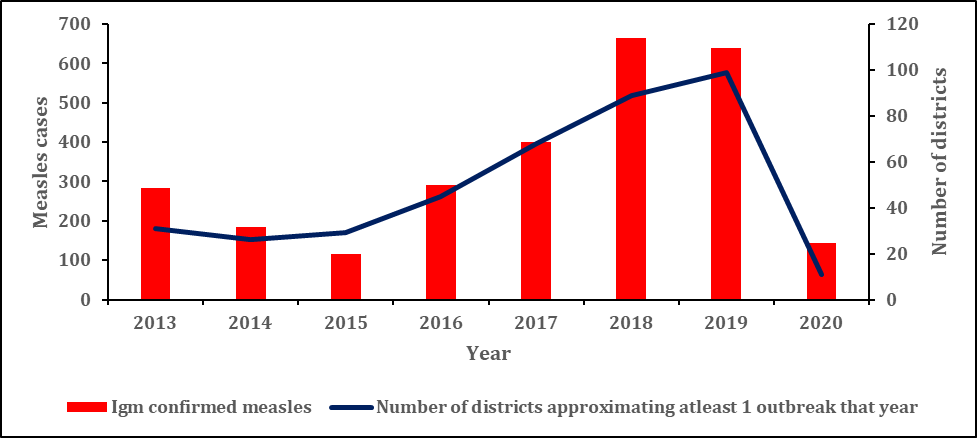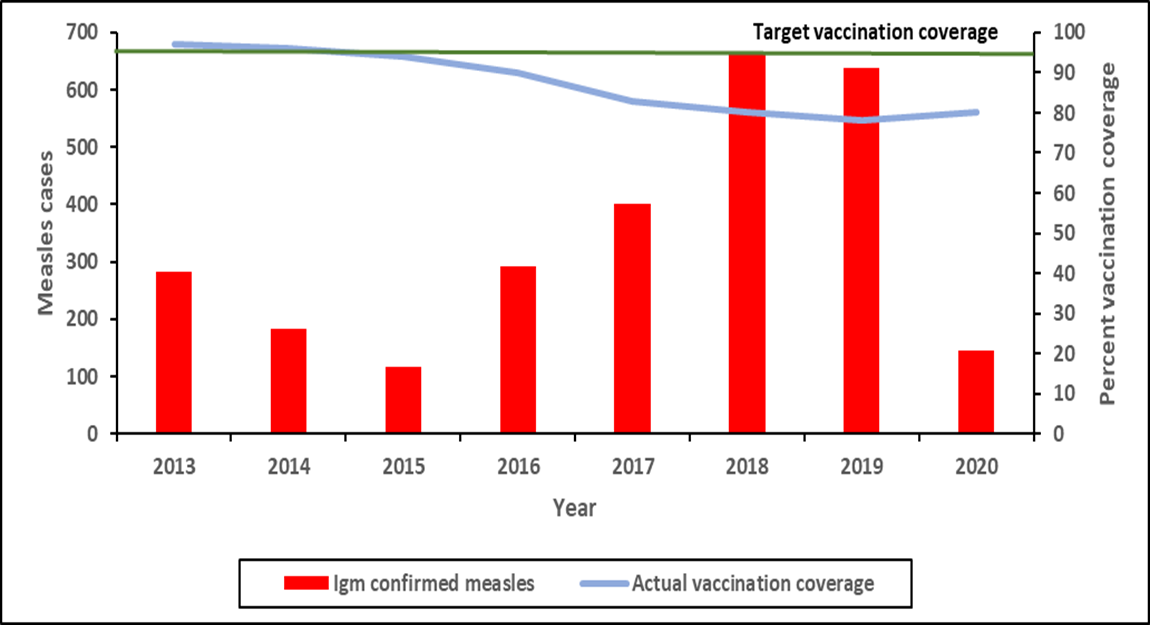Reduce missed measles vaccination opportunities to save our children: Policy brief
Improving national measles vaccination coverage among children under five in Uganda Authors: Elizabeth Katana*, Lilian Bulage, Aggrey Byaruhanga; Affiliation: Uganda National Institute of Public Health, Ministry of Health; Corresponding author*: Email: ekatana@musph.ac.ug, Tel: +256780384997
Key Messages
- Measles is Uganda’s most frequent disease outbreak in the past two decades.
- Measles vaccination coverage across the country remains low, below the target of 95% despite vaccines being offered for free and this is attributed to the Missed Opportunities for Vaccination (MOV) by the health system.
- Introducing the MOV policy will increase vaccination coverage from 80% to 96% and consequently reduce the number of confirmed measles cases by 65%.
Problem Statement
Measles is a highly infectious disease that can lead to severe illness, lifelong complications and death, particularly in Under-fives (1). An effective and accessible vaccination programme against measles exists globally and is offered free of charge in Uganda.
However, measles remains a major cause of vaccine preventable diseases. Measles outbreak has been ranked the most frequent disease outbreak (24%) in Uganda over the past two decades.
In the last three years, nearly two thirds of the 135 districts in the country have reported measles outbreaks with hospitalizations and deaths. Uganda identified more than twice as many confirmed measles cases between 2018 – 2020 (1,461) compared to 2013 – 2015 (581) when there were national measles vaccination campaigns.

Although the measles vaccination program in the country is targeted for children under five years old, with eligibility at nine months of age, the level of measles vaccination coverage across the country remains low, below the target of 95%.

One of the factors causing the low measles vaccination coverage is Missed Opportunities for Vaccination (MOVs). MOVs refers to any contact with health services by a child under five years who is eligible for measles vaccination, that does not result in the child receiving the vaccine dose (2).
MOVs include absence of routine screening for vaccination status or records by health workers, requiring caregivers to present cards or records to health facilities regardless of presenting complaints, poor record keeping, not opening a multidose vial for a small number of persons to avoid vaccine wastage and unfavorable vaccination schedule at the health facilities such as vaccines being given only once a week.
A policy focusing on the reduction of MOVs would enhance compulsory screening for vaccination status and therefore reach more children. Studies conducted in Nepal (3) and Kayunga District in Central Uganda showed that compulsory screening for vaccination status in children under-five increased vaccination coverage from 50% to 91% and 75% to 96% respectively (4).
Policy Options
We evaluated two measles vaccination strategies to observe their effect on the number of measles cases alongside the effect on the level of vaccination coverage.
Option 1
What: status quo
How: One dose of vaccination for measles through routine immunization at 9months alongside, vaccination of any child under-five years of age who is identified as not vaccinated, plus mop-up vaccination starting at 6months in case of an outbreak in a given area and mass vaccination campaign every three years depending on availability of resources and stakeholder engagements.
Challenge: Coverage is less than the target of 95% over the past decade (5).
Option 2
What: Compulsory screening of vaccination status for all children under- five
How: Compulsory screening of vaccination status for all children under-five through routine health service delivery regardless of their presenting complaints. This will be done alongside health education of parents or caretakers through community outreaches, and at the health facilities coupled with encouraging them to carry and present evidence of vaccination (home based vaccination records). The health facilities will be encouraged to increase the number of days when measles vaccination is offered (≥3 days a week). If a client has no card, but recalls vaccination status, they will be encouraged to come with it on the next visit; if client recalls vaccination status, but has lost their card, their status can be confirmed using the health facility vaccination record; if client has no card and does not recall vaccination status, they will be vaccinated and given a vaccination card.
Why: enhancing compulsory screening for vaccination status has resulted in increased vaccination coverage from a study in Nepal and a pilot study in Kayunga district (3,4).
Economic analysis
A comparative economic analysis was performed from the provider’s perspective to assess the value for money of Compulsory screening of vaccination status for all children under- five (option 2) relative to the status quo (policy option 1). Policy option 2 was economically favorable with incremental cost-effectiveness ratio (ICER) of US$0.92 (UGX 3,312) per case averted, relative to policy option 1 (Table 1). The ICER is not sensitive to changes in the effectiveness of the intervention and related variable costs.
| Outcome indicator | Option1:
Status Quo (UNEPI) |
Option 2:
Compulsory Screening |
| Target population reached | 8,823,606 | 8,823,606 |
| Total cases | 1,800,016 | 510,357 |
| Total costs | $10,251,951.91 | $11,440,534.03 |
| Incremental number of cases | – | -1,289,659 |
| Incremental cost | – | $1,188,582.12 |
| Incremental cost per case averted | – | -$0.92 |
| Political feasibility | High | Moderate |
| Operational feasibility | High | High |
Recommendations and next steps
Adopting the MOV policy will improve measles vaccination coverage and reduce missed opportunities for vaccination among under-fives. To achieve this, there is a need to develop policy strategy guidelines, train health workers, conduct community engagement and build partnerships. The strategy has been piloted at Kangulumira Health Centre IV in Kayunga district and has successfully shown results comparable to those seen in other countries that have adopted the policy including Nepal and India. Therefore, it is a feasible option.
Thus, adopting the policy of compulsory screening for measles vaccination status and improving measles vaccination coverage among under-fives, will subsequently reduce the number of confirmed measles cases in Uganda.
We recommend development of guidelines based on this strategy.
Acknowledgement
We appreciate the support of the Zambian-based mentors – Kutha Banda and Lawrence Mwenge, as well as our mentor from the CDC Foundation – Abidemi Fasanmi, who supported the team in every step of developing this policy brief including the economic analysis. Appreciation goes out to Kangulumira Health Centre IV in Kayunga District where a pilot study was conducted and generated the data for which this policy brief is based. We acknowledge the technical support of the CDC Foundation, Uganda Public Health Fellowship Program, Ministry of Health, and Makerere University School of Public Health. We thank the CDC-foundation for supporting the Uganda Public Health Fellowship Program activities and guiding the team to develop this policy brief.
References
- Morley D. THE PUBLIC HEALTH PROBLEM CREATED BY MEASLES IN THE DEVELOPING COUNTRIES. Arch Gesamte Virusforsch. 1965;16:19–26.
- World Health Organisation. Reducing Missed Opportunities for Vaccination (MOV) [Internet]. [cited 2021 Aug 25]. Available from: https://www.who.int/teams/control-of-neglected-tropical-diseases/yaws/diagnosis-and-treatment/essential-programme-on-immunization
- Acharya K, Lacoul M, Bietsch K. Factors affecting vaccination coverage and retention of vaccination cards in Nepal. 2019 Jan 1 [cited 2021 Aug 25]; Available from: https://dhsprogram.com/publications/publication-fa121-further-analysis.cfm
- Carrying of Home-Based Vaccination Records to Health Facilities for all Children below 5 years to Reduce Missed Opportunities for Vaccination in Kangulumira H.C IV in Kayunga district. Unpublished; 2017.
- WHO and UNICEF. Uganda: WHO and UNICEF estimates of immunization coverage: 2019 revision [Internet]. 2019. Available from: https://www.who.int/immunization/monitoring_surveillance/data/uga.pdf
Reference this Page as below
Elizabeth Katana*, Lilian Bulage, Aggrey Byaruhanga. Reduce missed measles vaccination opportunities to save our children: Policy brief. Kampala, Uganda. Uganda National Institute of Public Health, 2021 December 30th. Available from:https://uniph.go.ug/reduce-missed-measles-vaccination-opportunities-to-save-our-children-policy-brief.

